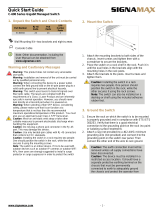
– 3 –
How to Use This Guide
This guide includes detailed information on the switch hardware, including
network ports, power, cabling requirements, as well as plug-in modules and
transceivers. This guide also provides general installation guidelines and
recommended procedures. To deploy this switch effectively and ensure
trouble-free operation it is recommended to first read the relevant sections in
this guide so that you are familiar with all its hardware components.
Who Should Read
This Guide?
This guide is for network administrators and support personnel that install,
operate, and maintain network equipment. The guide assumes a basic
working knowledge of LANs (Local Area Networks) and can be read by either
those that are new to network equipment, or those with more experience.
How This Guide is
Organized
The organization of this guide is based on the switch’s main hardware
components. Each chapter includes information about a specific component
with relevant specifications and installation procedures. A switch overview
section is also provided.
For Users New to Switches
— If you are new to network switches, it is
recommended that you first read all chapters in this guide before installing the
switch.
For Experienced Users
— If you are already familiar with installing and
operating network switches, the Switch Description and Installation Overview
chapters provide you with enough information to install the switch. Other
chapters can be left for reference, when needed.
The guide includes these chapters:
◆ Chapter 1 - Switch Description — Includes a switch overview, key
component identification and key technical specifications.
◆ Chapter 2 - Installation Overview — Includes details of the package contents
and an outline of switch installation tasks.
◆ Chapter 3 - Switch Chassis — Includes switch chassis rack installaion, and
system cooling requirements.
◆ Chapter 4 - Power and Grounding — Includes information on AC power
requirements, switch grounding, and powering on the switch.


























